Om to Bhagavan Vajravārāhī, prostrate!
Noble lady, mother of the three worlds whom others, cannot subdue,
Terrifyingly descending on all spirits, great Vajra Goddess herself!
Invincible Vajra-seat [Dorje Den] lady, whom others cannot beat; powerful, flashing eyes
Evaporating even poison; the lady with petrifying, wrathful clenched fangs
Shocking slaying and totally slaughtering; Queen who reigns over all.
All-Victorious Queen, stunning, paralysing and stupefying,
To Vajravārāhī, great yogini, powerful mistress of desire, bow down!
Those are the eight verses of Praise to Vārāhī.

For the Drigung Kagyu founder, Je Jigten Sumgon‘s commemoration, and Dakini day today, I offer some brand new research and translation on Nāropā’s Vajrayogini for Beginners practice and Drigung Kagyu and Vajrayogini. I have written about the Karmapas and Vajrayogini before here, but not about her connection with Drigung Kagyu.
This research arose during the teachings from a Vajrayogini retreat I attended this month (10-14 June 2022) given by Drigung Kagyu lama, Drupon Rinchen Dorje Rinpoche (more on that below). For the practice and retreat, Drupon compiled a new sadhana text, The Supreme Bestowal of Aspirations, with works by previous Drigung Kagyu masters. As the translation of this new sadhana did not include any references for sources cited of these compiled texts, I did some research on them using the Great Drigung Treasure of Dharma, a collection of texts within the Drigung Kagyu tradition (more on that below).
In this post, I offer:
- A new translation of a very short daily co-emergent Vajrayogini practice text [which could be used to do mantra accumulation] from the ‘mouth of Nāropā called ‘Vajrayogini for Beginners’, which he passed down to his student, Marpa. This text is identical to another text by Nāropā called ‘Co-emergent/Innate Vajravārāhī (Phagmo Lhankye). Available on request to those with a Kagyu or Marpa tradition Vajrayogini empowerment (and ideally permission and instruction from a qualified teacher).
- The first English-language catalogue of Drigung Kagyu texts on Vajrayogini based on the texts in the Drigung Kagyu Treasure of Dharma collection, including texts by Indian mahasiddhas Maitripa, Nāropā and Marpa.
- New translation (with textual sources) of Eight Verses of Praise to Vajravārāhī published in Karma Kagyu and Drigung Kagyu texts.
- A short overview the Drigung Kagyu lineage of Vajrayogini, direct from Vajrayogini to Tilopa, Nāropā, Marpa downwards to Pagmo Drupa, although it is not clear at all that Jigten Sumgon got this Vajrayogini lineage. Sarah Harding also has stated that the Dirigung Kagyu may not hold the lineage of Vajrayogini direct from Marpa.
This introduction, lineage details and catalogue, can also be downloaded as a .pdf on request here. It is wonderful indeed to be able to read the pith words of Nāropā and Marpa as preserved in writing on Vajrayogini practice.
Music? Wild Thing by the Troggs, ‘She’s Like a Rainbow’ by The Rolling Stones and Let Me Be Your Fantasy by Baby D…..’I’ll take you up to the highest heights, Let’s spread our wings and fly away, Surround you with love that’s pure delight. Release your spirit, set you free. Come and feel my energy. Let’s be as one in soul and mind. I’ll fill your world with ecstasy.”
May this new translation be of benefit in the flourishing of the Kagyu lineages and the accomplishment of the Queen of Bliss, Vajrayogini!
Written, compiled and translated by Adele Tomlin 23rd June 2022.
1. NAROPA’S ‘VAJRAYOGINI FOR BEGINNERS’ – SHORT SADHANA
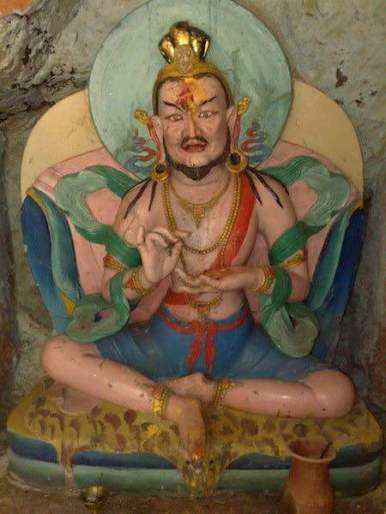
This Vajrayogini for Beginners: Concise Meditation practice (རྡོ་རྗེ་རྣལ་འབྱོར་མའི་སྒྲུབ་ཐབས་ལས་དང་པོ་པའི་སྒོམ་པ་མདོར་བསྡུས་པ།, rDo rje rnal ʼbyor maʼi sgrub thabs las dang po paʼi sgom pa mdor bsdus pa) was given orally by Nāropā is a very short and simple, 2-page visualisation practice of the innate/co-emergent Vajrayogini, and is the same text listed as the Innate Vajravarahi under that of Marpa Lotsawa in the Drikung Collection too.
Interestingly, Nāropā says that it is a concise version for beginners (las dang po pa). It involves a very easy and simple visualisation and seed syllable and can be combined with mantra recitation. A great gift from Nāropā (and Marpa) for those with little time!
It is not only included in the Drigung Kagyu Great Dharma Treasure (Cho Dzo Chenmo) (see details below), the text is also contained in three Tengyur editions:
- Peking Tengyur (dpe bsdur ma: Pe cin : Krung go’i bod rig pa’i dpe skrun khang, 1994),
- Narthang Tengyur (bsTan ʼgyur (snar thang), translated by Pu hrangs lo tsā ba, vol. 15, 1800, pp. 578–79. ], and
- Dege Tengyur (bsTan ʼgyur (sde dge), edited by Zhu chen tshul khrims rin chen, translated by Pu hrangs lo tsā ba, vol. 24, Delhi Karmapae Choedhey, Gyalwae Sungrab Partun Khang, 1982–1985, pp. 21–22.].
The colophons state: one that one edition came orally from Nāropā and was translated by Marpa Lotsawa, and arranged by Chogme Lotsawa (མར་པ་ཆོས་ཀྱི་བླ་གྲོས་ཀྱིས་བསྒྱུར་བ་རྫོགས་སོ།། གཞུང་དོན་གསལ་བྱེད་ཆན་བུ་འདི།་ཕྱོགས་མེས་ལོ་ཙཱས་གསལ་བར་བཀོད།) and one came from the oral instruction of Indian Master Pal Sumatikirti and was translated by the Tibetan translator, Gelong Prajnakirti (རྒྱ་གར་གྱི་མཁན་པོ་དཔལ་སུ་མ་ཏི་ཀཱིརྟིའི་ཞལ་སྔ་ནས།་བོད་ཀྱི་ལོ་ཙཱ་བ་དགེ་སློང་པྲཛྙ་ཀཱིརྟིས་བསྒྱུར་བའོ།).
For those with a Kagyu Vajrayogini empowerment, from a qualified Kagyu teacher, who would like to read and practice this short text, contact me here. For more on Nāropā’s Vajrayogini, as practiced in the Sakya lineage and Jamyang Khyentse Wangpo, see here.

2. THE DRIGUNG KAGYU GREAT TREASURE OF DHARMA (CHO DZO CHENMO) – VAJRAYOGINI TEXTS

Next, is a compilation of Vajrayogini/Vajravārāhī texts found in the 151 volume, publication of the Great Treasure of Drigung Kagyu texts (ʼBri gung bkaʼ brgyud chos mdzod chen mo. [ʼBri gung mthil dgon], 2004. Buddhist Digital Resource Center (BDRC), purl.bdrc.io/resource/MW00JW501203.) Interestingly, I could not see any texts listed by Tilopa, even though he is a direct lineage holder. Perhaps there are some contained in his vajra songs (another post!)
Maitrīpāda (c. 1007–1085)
- Praises to Vajrayogini (rDo rje rnal ʼbyor ma la bstod pa.) [i]
Nāropā (1016-1041)

- Co-emergent Vajravārāhī (Phag mo lhan skyes). Given orally by Nāropā and translated by Marpa Lotsāwa (Mar pa lo tsā ba chos kyi blo gros) [ii]
- Vajrayogini for Beginners: Concise Meditation practice (rDo rje rnal ʼbyor maʼi sgrub thabs las dang po paʼi sgom pa mdor bsdus pa.) Translated by Pandita Sumati Kirit (Paṇḍi ta sumati kirti) [iii].
These two seem to be different editions of the same text. Interestingly, this is different from the famous Naropa Khacheri Vajrayogini symbolism (as mainly practiced in the Sakya Lineage).
Marpa Lotsāwa (1012-1097)
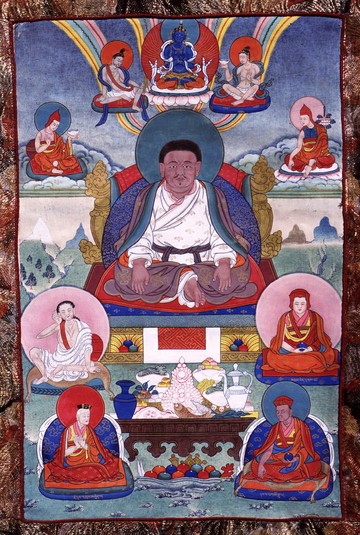
- Practice text of Vajrayogini (rDo rje rnal ʼbyor maʼi sgrub thabs.) Translated by Patsab Lotsawa Tsultrim Gyeltsan (Pa tshab lo tsā ba tshul khrims rgyal mtshan). [iv]
Seems to be the same text as the Naropa texts above.
Dagpo Lhaje – Gampopa (1079-1153)
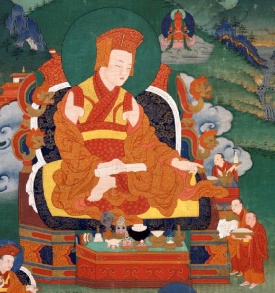
- Blessings of Vajrayogini (rDo rje rnal ʼbyor maʼi byin rlabs.) [v]
- Noble Varjavarahi’s Torma (rJe btsun rdo rje phag moʼi gtor ma)[vi]
- Vajrayogini’s Sadhana (rDo rje rnal ʼbyor maʼi sgrub thabs.)[vii]
- Ritual for the session torma of Noble Vajrayogini (rJe btsun rdo rje rnal ʼbyor maʼi thun gtor gyi cho ga.)[viii]
Rechungpa (Ras chung rdo rje grags pa) (1083-1161)

Milarepa’s other main student, Rechungpa’s texts are those of the fifteen deity and seven deity Vajravarahi mandala:
- Five, Seven and Fifteen Deity Vajravarahi Practice Texts from the Whispered Lineage (“sNyan brgyud las rdo rje phag mo lha mo bco lnga ma dang lha mo bdun ma lha mo lnga ma phag mo thugs sgrub.” ʼvol. 59, [ʼBri gung mthil dgon], 2004, pp. 333–42).
- Fifteen Deity Vajravarahi Practice Text “rDo rje phag mo lha mo bco lnga ma sgrub thabs.” (vol. 59, [ʼBri gung mthil dgon], 2004, pp. 334–39.)
- Seven Deity Vajravarahi Practice Text (“rDo rje phag mo lha mo bdun ma sgrub thabs.” (vol. 59, [ʼBri gung mthil dgon], 2004, pp. 339–41).
Je Jigten Sumgon (1143-1217)
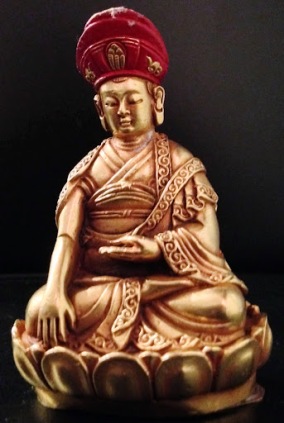
In Jigten Sumgon’s Collected Works (gSung ʼbum ʼjig rten mgon po, vol. 8, Drikung Kagyu Ratna Shri Sungrab Nyamso Khang, 2001, pp. 508–12), I could only find one Vajrayogini text:
- Pith Instructions on bringing beings under the power of Vajrayogini (rDo rje rnal ʼbyor maʼi sgo nas ʼgro ba gzhan dbang du sdud paʼi man ngag.)
Other Drigung Kagyu masters
Je Yanggonpa (1213-1258, Yang dgon pa rgyal mtshan dpal)
- Blessings of Vajrayogini (dPal rdo rje rnal ʼbyor maʼi byin rlabs.)[ix]
- Extremely Clear Mirror: Vajrayogini Sadhana (rDo rje rnal ʼbyor maʼi sgrub thabs rab gsal me long.) [x]
“Yanggonpa, the informal name he adopted, came from a hermitage he refers to in his Inner Autobiography as Yanggon (yang dgon), where he did his first Vajravārāhī retreat.
The fourth of Yanggonpa’s major teachers was Drigung Chennga Drakpa Jungne (‘bri gung spyan snga grags pa ‘byung gnas, 1175-1255), the fourth abbot of Drigung Til Monastery (‘bri gung mthil dgon) and a close disciple of Jikten Gonpo Rinchen Pel (‘jig rten mgon po rin chen dpal, 1143-1217), the founder of Drigung. Yanggonpa studied with Drakpa Jungne some time between 1247 and 1256, in his late thirties or early forties, and they developed a close bond. During one intense year of study, Yanggonpa received the entire Drigung Kagyu transmission, with special emphasis on the physical yogic exercises, along with the accompanying oral instructions. He also received from Chung Dorje Drakpa (gcung rdo rje grags pa, 1210-1278), Drakpa Jungne’s abbatial successor, the entire teachings of Pamodrupa Dorje Gyelpo (phag mo gru pa rdo rje rgyal po, 1110-1170).” (Treasury of Lives bio).
17th Drigung Seat-Holder, Gyalwang Rinchen Phuntsok (1527-1557) (rGyal dbang rin chen phun tshogs, https://library.bdrc.io/show/bdr:P399)
- Wishing-Fulfilling Grain of the Thoroughly Detailed Preparatory Ritual for the Two-faced Vajrayogini (rDo rje rnal ʼbyor ma zhal gnyis maʼi sta gon rab tu dbye ba dpag bsam snye ma.)[xi]
1st Drigung Chungtsang, Rigdzin Chokyi Dragpa (1595 – 1659) (ʼBri gung chung tshang 01 chos kyi grags pa, https://library.bdrc.io/show/bdr:P2666)
- Accomplishment of Vajrayogini (rDo rje rnal ʼbyor maʼi sgrub skor) [xii]
- Ship of Liberation: The complete four empowerments and garland of offerings. Vajrayogini Sadhana (rDo rje rnal ʼbyor maʼi sgrub thab smchod phreng dbang bzhi rdzogs su bskur ba thar pa dang dam paʼi gru rdzings.) ʼ[xiii]
- “dPal rdo rje rnal ʼbyor maʼi sgo nas las bzhiʼi sbyin sreg ʼdod don kun ʼbyin.” ʼ[xiv]
There is another Rigdzin Chokyi Dragpa short practice text not included in the Great Treasury called The Generation Stage Liberating Instructions of Bhagavati Vajrayoginī with Faces of the Two Truths (bCom ldan ʼdas ma rdo rje rnal ʼbyor maʼi bden gnyis zhal maʼi bskyed bzlas rgyun ʼkhyer.” (InʼBri gung rig ʼdzin chos kyi grags paʼi gsung thor bu) purl.bdrc.io/resource/MW1KG11858_F7C5FA.). In this text, the colophon says:
“Sangngag Rigdzin Chökyi Dragpa Trinle Namgyal, who has vigorously trained in this path from the Kyura family descendents of upper central Drigung and realized the dharmakāya luminosity of death, perfectly composed this text with pure three-fold scrutiny in the earth element rabbit year in the ninth month when the ḍākinīs gather on the waxing tenth day in the All-Illuminating Lattice-like Treasure House of Secret Mantra of the Tiger Peak Castle Mountain. Through this, may the precious teachings of the victorious ones, together with the deities, dwell for a very long time as a feast of benefit and happiness for all the nine types of beings! Śubhaṃstu sarvajagataṃ.”
This short daily generation stage text is commonly practiced within the Drigung Kagyu, and I was personally given the oral transmission for it last year by Drupon Rinchen Dorje Rinpoche.
Drigung Konchog Chokyab (b.1834 -) (ʼBri gung pa dkon mchog chos skyabs. http://purl.bdrc.io/resource/P2229)
- Ocean of Blessings of Great Secrets: Vajrayogini Sadhana (rDo rje rnal ʼbyor maʼi sgrub thabs gsang chen byin rlabs kyi rgya mtsho.)[xiii]
I was told by a Drigung Kagyu lama that this is the main Vajrayogini text practiced with Drikung Kagyu these days.
3. ‘EIGHT VERSES OF PRAISE TO VARAHI’: ORIGIN AND TEXTS

ཨོཾ་བཅོམ་ལྡན་འདས་མ་རྡོ་རྗེ་ཕག་མོ་ལ་ནི་ཕྱག་འཚལ་ལོ། །
om chomden dema dorjé pakmo la ni chaktsal lo/
Om to Bhagavan Vajravārāhī, prostrate!
འཕགས་མ་འཇིག་རྟེན་གསུམ་ཡུམ་གཞན་གྱིས་མི་ཐུབ་རིག་པའི་དབང་ཕྱུག་ཆེ། །
pakma jikten sum yum zhen gyi mi tub rigpé wangchuk ché/
Noble lady, mother of the three worlds[1], whom others.cannot subdue
འབྱུང་པོ་ཐམས་ཅད་འཇིགས་མཛད་ཀུན་ཏུ་འབེབས་མ་རྡོ་རྗེ་ཆེན་མོ་ཉིད། །
jungpo tamché jik dzé küntu beb ma dorjé chenmo nyi/
Terrifyingly descending on all spirits, great Vajra Goddess herself!
རྡོ་རྗེ་གདན་མ་མི་ཕམ་གཞན་གྱིས་མི་ཐུབ་དབང་མཛད་གཡོ་བའི་སྤྱན། །
dorjé den ma mipam zhen gyi mi tubwang dzé yowé chen/
Invincible Vajra-seat [Dorje Den][2] lady, whom others cannot beat; powerful, flashing eyes
དུག་ཀྱང་སྐེམ་པར་མཛད་མ་འཇིགས་སུ་རུང་བའི་ཁྲོ་མོ་གཙིགས་བྱེད་མོ། །
duk kyang kempar dzé ma jik su rungwé tromo tsik jemo/
Evaporating even poison; the lady with petrifying, wrathful clenched fangs
སྐྲག་བྱེད་གསོད་བྱེད་རབ་ཏུ་འབྱེད་པར་བྱེད་ཅིང་ཕ་རོལ་ལས་རྒྱལ་མ། །
trak jé sö jé rabtu jepar jé ching parol lé gyalma/
Shocking slaying and totally slaughtering; Queen who reigns over all.
རྣམ་པར་རྒྱལ་མ་རྨུགས་པར་བྱེད་ཅིང་རེངས་དང་རྨོངས་པར་མཛད་པ་མོ། །
nampar gyalma mukpar jé ching reng dang mongpar dzepa mo/
All-Victorious Queen, stunning, paralysing and stupefying
རྡོ་རྗེ་ཕག་མོ་རྣལ་འབྱོར་ཆེན་མོ་འདོད་པའི་དབང་ཕྱུག་མ་ལ་འདུད། །
dorjé pakmo naljor chenmo döpé wangchukma la dü
To Vajravārāhī, great yogini, powerful mistress of desire, bow down!
ཅེས་རྐང་བརྒྱད་ཀྱིས་བསྟོད
That is the eight verses of Praise to Vārāhī.
These ‘Eight verses to Varahi’, published in several Karma Kagyu and Drigung Kagyu texts [I list these below] are also re-produced in Drupon Rinchen Dorje Rinpoche’s text. However, the actual origin of the Praises is not clear, although Rinpoche explained that they are said to have arisen spontaneously from a yogi in India who saw Vajrayogini directly. If anyone knows the origin of these in more detail, please let me know!
Here is a list of the texts in which these Praises are published. The earliest one is from the 12th Century
- Collected Works of Gampopa in Blessings of the Five Deity Phagmo (“Phag mo lha lngaʼi cho ga byin rlabs ʼbyung gnas.”). In sGam poʼi gdan rabs rim byon gyi gsung ʼbum, Par gzhi dang po, vol. 16, Krung goʼi bod rig pa dpe skrun khang, 2013, pp. 235–63. Buddhist Digital Resource Center (BDRC), purl.bdrc.io/resource/MW1AC309_D11EE6.
- First Drikung Chungtsang: Chokyi Dragpa from the Mahamudra Vajra Primordial Awareness of the Mandala of the Sindha from Jomo Co-emergent (in rGyal dbang kun dgaʼ rin chen, et al. Phyag rgya chen mo rdo rje ye shes kyi sindhu raʼi dkyil ʼkhor las jo mo lhan cig skyes maʼi sgrub thabs dngos grub kyi ʼdod ʼjo sogs chos tshan khag cig. Buddhist Digital Resource Center (BDRC), purl.bdrc.io/resource/MW1KG4004).
- 4th Zhamarpa, Chodrag Yeshe (zhwa dmar 04 pa chos grags ye shes) from Sadhana of the front-generation five deity Bhagavan Co-emergent Chakrasamvara (bcom ldan ‘das bde mchog lhan skyes lha lnga’i mdun bskyed mchod pa’i cho ga). In: gsung ‘bum/ chos grags ye shes. gSung ʼbum chos grags ye shes, Par gzhi dang po, vol. 1, Krung goʼi bod rig pa dpe skrun khang, 2009, pp. 750–55. Buddhist Digital Resource Center (BDRC), purl.bdrc.io/resource/MW1KG4876_956D3A).
ENDNOTES FOR PRAISES
[1] The three realms are the desire realm, form realm, and formless realm. it is also known as srid pa’i gsum, the “three realms of existence.”
[2] The Tibetan term here is rdo rje ldan, which literally means ‘vajra seat’ but is also used by Tibetans to refer to Bodh Gaya the place where Buddha attained enlightenment.
Translated by Adele Tomlin, 23rd June 2022.
4.VAJRAYOGINI AND THE DRIGUNG KAGYU LINEAGE
The Vajrayogini practiced by Drigung Kagyu came down from Vajrayogini, to Tilopa, Naropa, to Marpa on to Phagmodrupa. For example, in the Collected Works of Drigung Kagyu master, Kunga Rinchen (‘bri gung gdan rabs 16 kun dga’ rin chen) (1475-1527) cites the lineage of the Innate Vajrayogini (phag mo lhan skyes kyi dbang gi brgyud lugs gcig la/) as :
Vajradhara rdo rje ‘chang*/ Vajravarahi (rdo rje phag mo/) Tilopa_ til+li/Naropa (nA ro/ Marpa (mar pa/), Milarepa (mi la/) Gampopa (sgam po pa/) Phagmo Drupa (phag mo) Ratna Radza (rat+na ra dza)/Dharma Radza (d+harma rA dza/ bdr:P2885), Nubchen Sangye Yeshe (gnubs chen sangs rgyas ye shes/), Namkha Gyeltsan (nam mkha’ rgyal mtshan/) Ngawang Gyeltsen (ngag dbang rgyal mtshan/) Nyam-med Ngawang Dragpa (_mnyam med ngag dbang grags pa/), Sung-rab Rinpoche (gsung rab rin po che/) des bdag la’o/
I was also told by a Driking Kagyu lama that the Drigung lineage for the five deity Varahi is the same going through from Tilopa to Phagmo Drupa.
In addition, I was informed that there is also a Drigung Kagyu lineage of the five deity Chakrasamvara that comes directly through Vajrayogini, to Lakshminkara, Birwapa, Awadhutipa, Sharawipa, Palden Dompupa…. see Tibetan of that lineage below here.
I have been unable to find any text that states how the Vajrayogini lineage was passed onto Jigten Sumgon though. He is listed in the five deity Chakrasamvara lineages but not in any of the Vajrayogini lineages I have seen.
Also, Lama Sarah Harding in “As for the Blessing of Vajravārāhī, Marpa Lhodrakpa does not have it.” WTF? suggests that the Drigungpa do not hold the empowerment conferral lineage:
“The sDom gsum rab dbye [is a reference to] the Nyingma tradition of the Sow-headed One (Phag-mgo), the Archer (mda’ gzhu), Mirror (me long) and so forth that have a symbol blessing attached. The taking of the vows of the five families and so on, the prelude (sta gon), entering ritual, distributing the vase water upon entering the main part, and adding on the concluding [auspicious verses] at the end were done by the old Dri[gungs] sentinels (‘gri rgan gyi chos sgo ba). This does not constitute an authentic empowerment conferral, and it is not the lineage coming from Marpa Lotsāwa. It is also not the true pure tradition of the Nyingma. [Sakya Paṇḍita] was thinking that it was a shame to bestow the Sarma instructions of Nāropa’s Six Dharmas through opening the door of a great counterfeit Dharma, and [therefore] he refuted it. Blame it on the Drigungpas. I can live with that.”
I also have not seen any text which clearly states that Jigten Sumgon got the Vajrayogini lineage direct from Marpa Lotsawa. If anyone can help with that please do let me know!
5. THE SUPREME BESTOWAL OF ASPIRATIONS: CO-EMERGENT VAJRAVARAHI SADHANA – NEW COMPILATION SADHANA BY DRUPON RINCHEN DORJE RINPOCHE
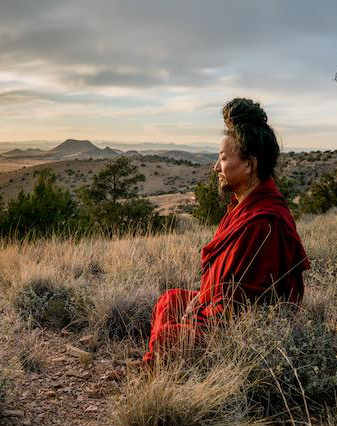
In February 2022, as a new addition to the Drigung Kagyu corpus, Drupon Rinchen Dorje Rinpoche published for the first time a new compiled co-emergent Vajrayogini sadhana, which he gave detailed teachings on this month (June 2022). The text opens with a short history of the Vajrayogini teachings, said to have been given by Naropa to Marpa directly:
“At his hermitage in Pushpahari, the pandita Naropa told the king of translators, Marpa, “I am entrusting you with an exceptional Dharma from the Dakini Hearing Lineage which you have never heard of prior to this.” Then using mandalas of sindura, he bestowed the empowerments for the mother Vajra Varahi as the fifteen, seven, and five dakinis, as well as the co-emergent dakini. Relying on the mandala of the guru’s enlightened body, speech, and mind, he gave all the symbol empowerments and pith instructions in their entirety. He then said, “give these to your disciple known as Töpagha, for his enlightened activity will flourish and spread.”

The king of translators, Marpa Lotsawa later told Jetsün Milarepa, “through this supreme gift of pith instructions from the Dakini Hearing Lineage, I will transfer everything to you, fully filling the vase. I can guarantee that these words of mine are without deceit. There is nothing in the pith instructions which has been added or omitted, as the Lama and Yidam are my witness, this I solemnly swear,” and so saying he gave the empowerments and pith instructions in all their entirety to Milarepa.”
“Then when Gampopa first met Milarepa, Jetsün Milarepa said to him, “it is not that the empowerments which have been bestowed upon you prior to this are useless but because of the greater auspiciousness of interdependence, I shall grant you the blessings from my own tradition.” Then based on the mandala of sindura from the tradition of the hearing lineage, he conferred the blessing of Vajra Varahi. Out of all the entirety of empowerments and pith instructions he gave, this Co-emergent Jetsün Vajrayogini is like the innermost heart essence of the exceptional Dakini Hearing Lineage. She has been practiced by all the Kagyu masters of the past, who regarded her as their foremost yidam deity, from Vajradhara up to the present root guru. By practicing her, they encountered the full culmination of experience and realization.”
The textual origin of this history is not given in the text. I have tried to find the origins of these words in source texts but unable to source them and when I asked Rinpoche directly, he was unable to give a source either. If anyone knows, please let me know.
Drupon Rinpoche wrote that the reason for composition was:
“Nowadays, when everyone is busy and bustling with activity, someone of inferior intelligence like myself can rarely find the time to practice extensive sadhanas. Furthermore, when translated into different languages, there are even more words [to recite] and it can be difficult to manage in terms of time etc. Since I have yet to come across an abbreviated Co-emergent Vajrayogini sadhana, from this tradition, in which everything is complete; with the hope that it might be of some benefit to those of lesser intelligence like myself, I have excerpted the self-generation of Vajrayogini while preserving its original form, from “The Oral Instructions of Naropa on the Six Yogas,” composed by the omniscient Rigdzin Chödrag. The preliminaries, concluding sections, and offerings etc. come from the Varahi sadhana “The Ship of Liberation.” I have supplemented them with sections from “The Ocean of Blessings from the Great Secret,” composed by Tripön Könchog Chökhyab. I have also added some words from the Kagyu masters of the past. In this way I have created some fabricated semblance of an arrangement comprising an abbreviated Varahi sadhana.
If there are faults or errors, I confess them from my heart to all those endowed with the wisdom eye. Dedicating the virtue so that all sentient beings may swiftly reach the state of the victorious mother Vajra Varahi, this was composed in the land of North America, in the state of Arizona, in my retreat cabin at Garchen Buddhist Institute in between sessions while practicing the approach and accomplishment of the supreme mother of all buddhas of the three times, Vajra Varahi. Compiled and arranged by Güngpa Rinchen Dorje of Rusar, who was born in a region of the glorious Gyalwa Drikungpa’s teachings.”
Despite this sadhana having been compiled and published several months ago, and despite my requests for them, the sources and full names of these texts were not provided in the English translation by Virginia Blum or by Drupon Rinpoche. However, after my own research into it, I can now inform readers that they are all in the Drigung Kagyu texts given in the catalogue above. The ‘Ship of Liberation’ was also composed by Rigdzin Chokyi Dragpa. although the spelling and name of the text is cited incorrectly in the Tibetan Introduction.

The new compiled sadhana is 47 pages long (in English, Tibetan and phonetics), unlike Naropa’s simple 2-page version! The main differences are the offerings, praises, Vajrasattva and torma sections. The Vajrasattva is the Heruka/wrathful form of Vajrasattva, which I wrote about ijn the context of Kalacakra preliminaries, here. There is no explanation provided about the wrathful form of the mantra and why it is being used in this text though.
The self-generation section is a word-for-word copy of Rigdzin Chodrag’s The Generation Stage Liberating Instructions of Bhagavati Vajrayoginī with Faces of the Two Truths, which I also mentioned above.
ENDNOTES FOR ARTICLE
[i] ʼBri gung bkaʼ brgyud chos mdzod chen mo, edited by Ra se dkon mchog rgya mtsho and ʼBri gung a mgon rin po che, translated by Zhang lo tsā ba grub pa dpal, vol. 2, [ʼBri gung mthil dgon], 2004, pp. 179–86.
[ii] vol. 3, [ʼBri gung mthil dgon], 2004, pp. 221–24.
[iii] ʼvol. 4, [ʼBri gung mthil dgon], 2004, pp. 39–40.
[iv] vol. 5, [ʼBri gung mthil dgon], 2004, pp. 94–95.
[v] vol. 11, [ʼBri gung mthil dgon], 2004, pp. 33–38.
[vi] vol. 11, [ʼBri gung mthil dgon], 2004, pp. 38–39.
[vii] translated by Pa tshab lo tsā ba tshul khrims rgyal mtshan, vol. 11, [ʼBri gung mthil dgon], 2004, pp. 39–43.
[viii] vol. 11, [ʼBri gung mthil dgon], 2004, pp. 43–45.
[ix] vol. 48, [ʼBri gung mthil dgon], 2004, pp. 206–22.
[x] vol. 48, [ʼBri gung mthil dgon], 2004, pp. 540–62.
[xi] vol. 67, [ʼBri gung mthil dgon], 2004, pp. 159–80.
[xii] , vol. 106, [ʼBri gung mthil dgon], 2004, pp. 532–606.
[xiii] vol. 106, [ʼBri gung mthil dgon], 2004, pp. 532–78.
[xiv] vol. 106, [ʼBri gung mthil dgon], 2004, pp. 578–606.
[xiii] vol. 131, [ʼBri gung mthil dgon], 2004, pp. 197–300.


Dear Adele, Yes I did receive a Vajrayogini empowerment from Traga Rinpoche and would like to receive the text you mentioned here. I hope all is well my sweet Dharma sister. All the Best,Paul
Hello Paul! Thanks, yes will add you to the growing list of names and send in the next couple of days. Hope all is well 🙂